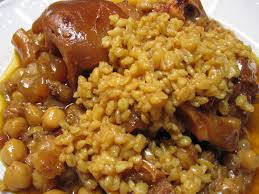The Unique World of Cow Feet: Culinary Delicacies and Beyond
Cow feet, often referred to as cow trotters, may not be the first thing that comes to mind when thinking of culinary delights. However, these gelatinous and flavorful cuts are cherished in various cuisines across the globe, particularly in Asia, Africa, Latin America, and the Caribbean. While not as commonly consumed in Western cuisine, cow feet offer a unique texture and rich flavor that make them a prized ingredient in many traditional dishes.
Understanding Cow Feet

Cow feet consist primarily of skin, tendons, cartilage, and bones, with little to no muscle or meat. This composition gives them a distinctive gelatinous texture when cooked, making them a popular choice for soups, stews, and broths. The prolonged cooking process extracts gelatin from the tendons and cartilage, resulting in a thick, hearty broth that is both nutritious and flavorful.
In many cultures, cow feet are considered a delicacy, often reserved for special occasions or traditional dishes. The preparation of cow feet varies widely depending on regional tastes and culinary traditions, but the end result is typically a dish that is rich in flavor and texture.
Culinary Uses of Cow Feet

Cow feet are used in a variety of dishes around the world, each with its own unique preparation method and flavor profile. Here are some notable examples:
- Gulai Tunjang (Indonesia)
- A popular dish in Minangkabau cuisine, gulai tunjang is a spicy curry made from cow feet. The trotters are slow-cooked in a rich, spiced coconut milk broth, resulting in a tender and flavorful dish that is often served with rice.
- Soto Kaki Sapi (Indonesia)
- Soto kaki sapi is a traditional Indonesian soup made from cow feet, featuring a clear broth flavored with spices, garlic, and lemongrass. The dish is known for its comforting qualities and is often enjoyed as a hearty meal.
- Caldo de Mocotó (Brazil)
- In Brazil, cow feet are used to make caldo de mocotó, a nutritious soup that is especially popular in the northeastern region. The soup is made by simmering cow feet with vegetables and spices until the broth becomes thick and gelatinous.
- Cow Foot Stew (Jamaica)
- In Jamaican cuisine, cow foot stew is a beloved dish made by slow-cooking cow feet with beans, spices, and vegetables. The result is a rich, flavorful stew that is often served with rice or dumplings.
- Khash (Armenia, Azerbaijan, Iran)
- Khash is a traditional dish in Armenia, Azerbaijan, and Iran, made by simmering cow feet with garlic and vinegar. The dish is typically enjoyed in the early morning hours, often accompanied by bread and vodka.
- Paya (Pakistan)
- Paya is a popular Pakistani dish made from cow feet, slow-cooked with spices, onions, and tomatoes. The dish is known for its rich, flavorful broth and is often served with naan or rice.
Cultural Significance of Cow Feet
Beyond their culinary uses, cow feet hold cultural significance in many societies. In some regions, they are believed to have health benefits, particularly for joint health due to their high collagen content. In Cabo Verde, for example, a traditional dish called mão de vaca is believed to enhance stamina and is often consumed after a night of dancing.
In Africa, dishes made from cow feet are often associated with celebration and hospitality. They are commonly served at family gatherings, weddings, and other special occasions, symbolizing abundance and good fortune.
Foot-and-Mouth Disease and Its Impact
While cow feet are enjoyed in many cuisines, it’s important to be aware of the potential risks associated with them, particularly in regions affected by Foot-and-Mouth Disease (FMD). FMD is a highly contagious viral disease that affects cloven-hoofed animals, including cows, pigs, sheep, and goats. The disease can have severe economic impacts, as it weakens animals and reduces their productivity.
Efforts to control and eradicate FMD are ongoing worldwide, with measures in place to prevent its spread, especially through the transportation of animals and animal products. These efforts are crucial in maintaining the safety and quality of food products derived from cloven-hoofed animals, including cow feet.
Conclusion
Cow feet, though often overlooked in Western cuisine, are a versatile and culturally significant ingredient in many parts of the world. Their unique texture and rich flavor make them a valuable addition to a wide range of dishes, from soups and stews to curries and broths. Whether you’re exploring the culinary traditions of Indonesia, Brazil, Jamaica, or beyond, cow feet offer a taste of history, culture, and comfort that is truly one-of-a-kind.




